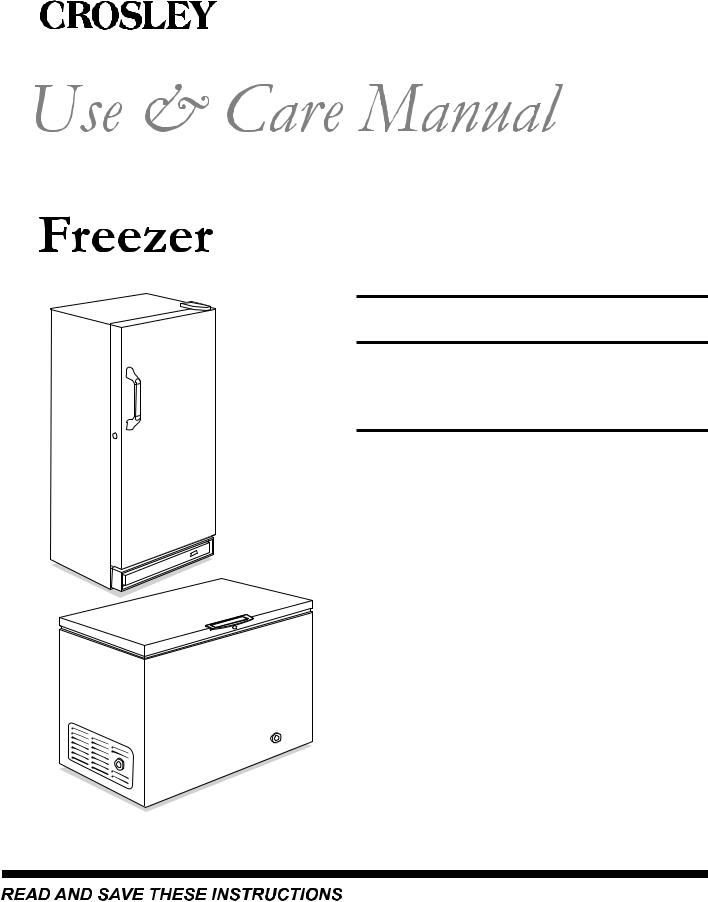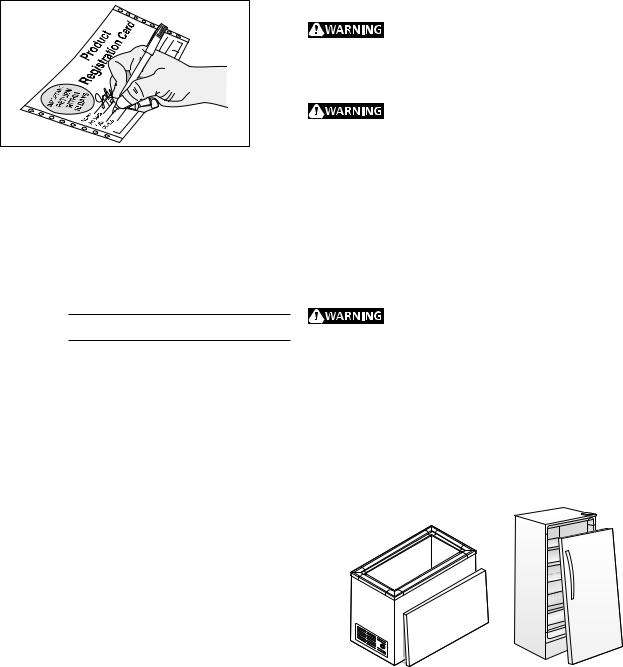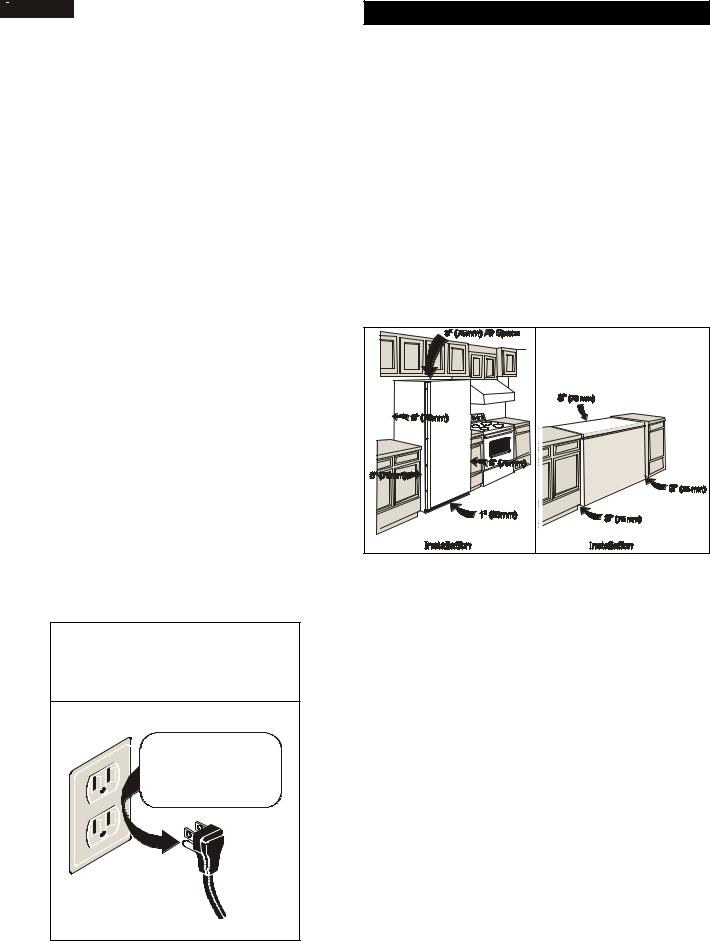Crosley CFCH20LW, CFCH25LW, CFCH15LW, CFC05NW, CFC09LW Owner's Manual
...
Product Registration.............................. |
2 |
Important Safety Instructions............... |
2 |
First Steps............................................ |
2-3 |
Energy Saving Ideas........................... |
3-4 |
Setting the Temperature Control.......... |
4 |
Freezer Optional Features.................. |
4-6 |
Care and Cleaning............................... |
7-8 |
Power Failure/ |
|
Freezer Failure........................................ |
8 |
Avoid Service Checklist................... |
9-10 |
Warranty................................................ |
11 |
297334700 (January 2010)

PRODUCT REGISTRATION |
|
IMPORTANT SAFETY INSTRUCTIONS |
|
|
|
The information contained in this Use and Care Guide will instruct you on how to properly operate and care for your product. Please read through the information contained in your literature pack to learn more about your new freezer.
Record your Model and Serial Numbers
Record the model number and serial number of this freezer in the space provided below.
Model No.
Serial No.
Register Your Product
The self-addressed PRODUCT REGISTRATION CARD
(shown above) should be filled in completely, signed and returned to Crosley Corporation.
This Use and Care Guide provides operating instructions for your model. Use your freezer only as instructed in this Use and Care Guide.
2
Read all instructions before using this freezer.
For your safety
Do not store or use gasoline or other flammable vapors and liquids in the vicinity of this unit or any other appliance. Read product labels for flammability and other warnings.
Child Safety
•Destroy carton, plastic bags, and any exterior wrapping material immediately after the freezer is unpacked.Children should never use these items for play. Cartons covered with rugs,bedspreads,plasticsheetsorstretchwrapmaybecome airtight chambers and can quickly cause suffocation.
•A child might suffocate if he crawls into the freezer to hide or play. Remove the door/lid of the freezer when not in use, even if you plan to discard the freezer. Many communities have laws requiring you to take this safety precaution.
•Remove or discard any spacers used to secure the shelves during shipping. Small objects are a choke hazard to children.
Risk of Child Entrapment
Child entrapment and suffocation are not problems of the past. Junked or abandoned refrigerators or freezers are still dangerous – even if they will sit for “just a few days”. If you are getting rid of your old refrigerator or freezer, please follow the instructions below to help prevent accidents:
•Remove the door/lid. If your door has electronic controls, have it removed by a qualified technician.
•Leave shelves in place so children may not easily climb inside.
•Have the refrigerant removed by a qualified technician.



 WARNING Electrical Information
WARNING Electrical Information
These guidelines must be followed to ensure that safety mechanisms in the design of this freezer will operate properly.
•Refer to the serialplate for correct electrical rating.
The power cord of the appiiance is equipped with a three prong plug for your protection against shock hazards. It must be plugged directly into a properly groundedthree prong receptacle, protected with a 15 amp timedelay fuse or circuit breaker. The receptacle must be installed in accordance with local codes and ordinances. Consult a qualified electrician.
Receptacles protected by Ground Fault Interrupters (GFI) are NOT RECOMMENDED. DO NOT USE AN
EXTENSION CORD OR ADAPTER PLUG.
•If voltage varies by 10% or more, freezer performance may be affected. Operating freezer with insufficient power can damage the motor. Such damage is
not covered under the warranty. If you suspect your household voltage is high or low, consult your power company for testing.
•To prevent the freezer from being turned off accidentically, do not plug unit into an outlet controlled by a wall switch or pull cord.
•Do not pinch, knot, or bend the cord in any manner.
Other Precautions
•To defrost freezer, always unplug unit first.
•Never unplug the freezer by pulling on the cord. Always grip the plug firmly, and pull straight out from the receptacle.
•Turning the temperature control to OFF turns off the compressor, but does not disconnect the power to the light bulb or other electrical components.
 Avoid fire hazard or electric shock. Do not use an extension cord or an adapter plug. Do not remove any prong from the power cord.
Avoid fire hazard or electric shock. Do not use an extension cord or an adapter plug. Do not remove any prong from the power cord.
Grounding type wall receptacle
Do not, under any circumstances,
cut, remove, or bypass the
grounding prong.
Power supply cord with 3-prong grounding plug
FIRST STEPS
This Owner’s Guide provides specific operating instructions for your model. Use the freezer only as instructed in this Owner’s Guide. Before starting the freezer, follow these important first steps.
Installation
•Choose a place that is near a grounded electrical outlet. Do Not use an extension cord or an adapter plug.
•For the most efficient operation, the freezer should be located where surrounding temperatures will not exceed 110°F (43°C).Temperatures of 32°F (0°C) and below will NOT affect freezer operation. Additional compressor heaters are not recommended.
•Allow space around the unit for good air circulation.
Leave a 3 inch (75 mm) space on all sides of the freezer for adequate circulation.
NOTE: The exterior walls of the freezer may become quite warm as the compressor works to transfer heat from the inside. Temperatures as much as 30° F warmer than room temperature can be expected. For this reason it is particularly important in hotter climates to allow enough space for air circulation around your freezer.
Leveling
The freezer must have all bottom corners resting firmly on a solid floor. The floor must be strong enough to support a fully loaded freezer. NOTE: It is Very Important for your freezer to be level in order to function properly. If the freezer is not leveled during installation, the door may be
misaligned and not close or seal properly, causing cooling, frost, or moisture problems.
To Level Upright Models:
After discarding crating screws and wood base, use a carpenter’s level to level the freezer from front-to-back. Adjust the plastic leveling feet in front, ½ bubble higher, so that the door closes easily when left halfway open.
FI3RST

Turn |
Left To |
Raise |
Turn |
Right To |
Lower |
Plastic |
Leveling Feet |
Crating |
Screw |
Discard The (4) Crating Screws |
And (2) Wood Bases |
Unpacking and Leveling -- Upright Models |
To Level Chest Models:
If needed, add metal or wood shims between foot pads and floor.
cleaning (Prior to use)
•Wash any removable parts, the freezer interior, and exterior with mild detergent and warm water. Wipe dry.
Do not use harsh cleaners on these surfaces.
•Do not use razor blades or other sharp instruments, which can scratch the appliance surface when removing adhesive labels. Any glue left from the tape can be removed with a mixture of warm water and mild detergent, or touch the residue with the sticky side
of tape already removed. Do not remove the serial plate.
 To allow door to close and seal properly, DO NOT let food packages extend past the front of shelves.
To allow door to close and seal properly, DO NOT let food packages extend past the front of shelves.
Shelf Front
Door Removal (NON-ELECTRONIC MODELS)
If door must be removed:
1.Gently lay freezer on its back, on a rug or blanket.
2.Remove two base screws and base panel.
3.Remove bottom hinge screws.
4.Remove plastic top hinge cover.
5.Remove screws from top hinge.
6.Remove top hinge from cabinet.
7.Remove door and bottom hinge from cabinet.
8.To replace door, reverse the above order and securely tighten all screws to prevent hinge slippage.
Door Removal (ELECTRONIC MODELS)
If door must be removed:
•Door hinge is fastened with tamper-proof screws.
Please have a qualified technician remove the door.
ENERGY SAVING TIPS
|
E |
A |
V |
|
|
S |
|
S AVE
M |
|
|
|
• |
|
|
|
|
|
O |
|
|
|
|
|
N |
|
||
|
|
E |
|
|
|
|
|
Y |
|
|
|
G |
Y |
• |
|
|
|
||
|
R |
|
||
|
|
|
||
E |
|
|
|
|
EN |
|
|
|
|
The freezer should be located in the coolest area of the room, away from heat producing appliances or heating ducts, and out of direct sunlight.
Let hot foods cool to room temperature before placing in the
freezer. Overloading the freezer forces the compressor to run longer. Foods that freeze too slowly may lose quality or spoil.
•Be sure to wrap foods properly, and wipe containers dry before placing them in the freezer. This cuts down on frost build-up inside the freezer.
•Freezer shelves should not be lined with aluminum foil, wax paper, or paper toweling. Liners interfere with cold air circulation, making the freezer less efficient.
•Organize and label food to reduce door openings and extended searches. Remove as many items as needed at one time, and close the door as soon as possible.
SETTING THE temperature CONTROL
Cool Down Period
•For safe food storage, allow 4 hours for the freezer to cool down completely. The freezer will run continuously for the first several hours. Foods that are already frozen may be placed in the freezer after the first few hours of operation. Unfrozen foods should NOT be loaded into the freezer until the freezer has operated for 4 hours.
•When loading the freezer, freeze only 3 pounds of fresh food per cubic foot of freezer space at one time. Distribute packages to be frozen evenly throughout the freezer. It is not necessary to turn the control knob to a colder setting while freezing food.
4
